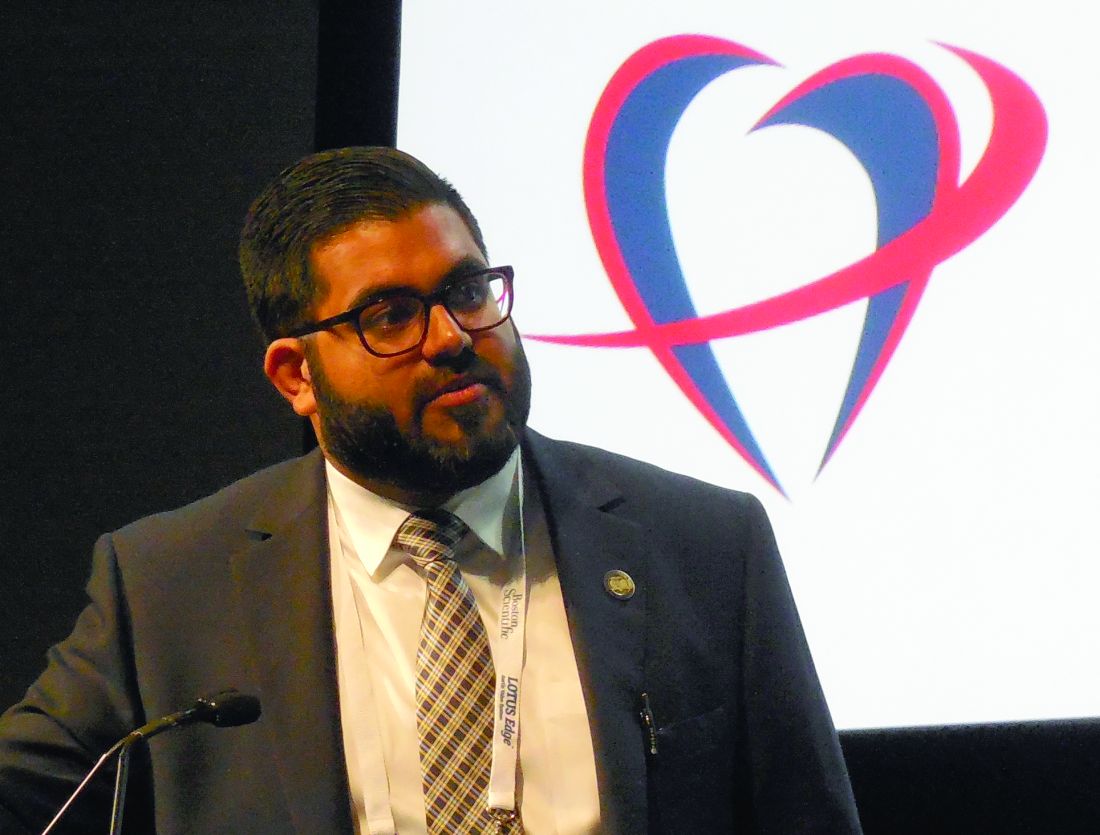User login
LAS VEGAS – A novel protocol for acute management of patients in cardiogenic shock secondary to an acute MI that started hemodynamic support prior to coronary revascularization produced an unprecedented in-hospital survival rate of 72% in 171 patients treated at any of 35 U.S. centers.
The 72% acute survival compares with historical rates of roughly 50% starting with the landmark SHOCK trial from 1999 (N Engl J Med. 1999 Aug 26;341[9]:625-34) and continuing in much more recent reports (J Am Coll Cardiol. 2017 Jan 24;69[3]:278-87)
“This is a first step toward reducing the futility in treating a disease where management has not changed for more than 20 years,” Mir B. Basir, D.O., said at the annual scientific sessions of the Society for Cardiovascular Angiography and Interventions. While Dr. Basir acknowledged that the new protocol needs further testing, as well as further improvement, a need exists to immediately implement changes in the routine management of cardiogenic shock caused by an acute MI because “50% in-hospital survival is no longer acceptable,” said Dr. Basir, an interventional cardiologist at the Henry Ford Health System in Detroit.
The National Cardiogenic Shock Initiative operates as a single-arm study with no control group. The novel management protocol used by the Initiative in the current study included the following five key best-practice steps, Dr. Basir said in a video interview:
1. Begin hemodynamic support before increasing dosages of vasopressors or inotropes.
2. Use right-heart catheterization to monitor the patient’s hemodynamics, which shows the efficacy of the hemodynamic support and guides tapering down of vasopressor and inotrope drugs.
3. Apply hemodynamic support before starting percutaneous coronary intervention (PCI).
4. Act fast, with a goal of less than 90 minutes from door to hemodynamic support. In the 171 patients that Dr. Basir reviewed, the average door-to-support time was 85 minutes.
5. Mitigate complications from the devices and vascular access.
This protocol started at four hospitals in the Detroit region, and then expanded to the National Cardiogenic Shock Initiative that now includes 68 U.S. sites and more than 200 patients treated, with another 23 U.S. hospitals about to join. The 68 active sites include 26 academic centers and 42 community hospitals. The initiative has enrolled patients who match the enrollment criteria of the SHOCK trial so that historical comparisons are possible. The initiative’s patients would be classified as class C, D, or E patients based on the society’s newly published cardiogenic shock classification scheme (Catheter Cardiovasc Interv. 2019 May 19. doi: 10.1002/ccd.28329).
“The numbers that Dr. Basir has reported are very encouraging and provocative,” commented Chandanreddy M. Devireddy, MD, an interventional cardiologist at Emory Healthcare in Atlanta. “In light of the fact that we have had few solutions for these patients, this will accelerate the discussion.”
Several barriers exist for widespread adoption of the initiative’s protocol, Dr. Basir said. The protocol requires a lot of resources and the ability to deliver this care 24/7. Currently, hemodynamic support is “greatly underused,” and right-heart catheterization is not standard of care for these patients at many U.S. centers, he noted.
A few weeks before Dr. Basir’s report at the meeting, his data from the National Cardiogenic Shock Initiative appeared in an article published online (Catheter Cardiovasc Interv. 2019 Apr 25. doi: 10.1002/ccd.28307).
LAS VEGAS – A novel protocol for acute management of patients in cardiogenic shock secondary to an acute MI that started hemodynamic support prior to coronary revascularization produced an unprecedented in-hospital survival rate of 72% in 171 patients treated at any of 35 U.S. centers.
The 72% acute survival compares with historical rates of roughly 50% starting with the landmark SHOCK trial from 1999 (N Engl J Med. 1999 Aug 26;341[9]:625-34) and continuing in much more recent reports (J Am Coll Cardiol. 2017 Jan 24;69[3]:278-87)
“This is a first step toward reducing the futility in treating a disease where management has not changed for more than 20 years,” Mir B. Basir, D.O., said at the annual scientific sessions of the Society for Cardiovascular Angiography and Interventions. While Dr. Basir acknowledged that the new protocol needs further testing, as well as further improvement, a need exists to immediately implement changes in the routine management of cardiogenic shock caused by an acute MI because “50% in-hospital survival is no longer acceptable,” said Dr. Basir, an interventional cardiologist at the Henry Ford Health System in Detroit.
The National Cardiogenic Shock Initiative operates as a single-arm study with no control group. The novel management protocol used by the Initiative in the current study included the following five key best-practice steps, Dr. Basir said in a video interview:
1. Begin hemodynamic support before increasing dosages of vasopressors or inotropes.
2. Use right-heart catheterization to monitor the patient’s hemodynamics, which shows the efficacy of the hemodynamic support and guides tapering down of vasopressor and inotrope drugs.
3. Apply hemodynamic support before starting percutaneous coronary intervention (PCI).
4. Act fast, with a goal of less than 90 minutes from door to hemodynamic support. In the 171 patients that Dr. Basir reviewed, the average door-to-support time was 85 minutes.
5. Mitigate complications from the devices and vascular access.
This protocol started at four hospitals in the Detroit region, and then expanded to the National Cardiogenic Shock Initiative that now includes 68 U.S. sites and more than 200 patients treated, with another 23 U.S. hospitals about to join. The 68 active sites include 26 academic centers and 42 community hospitals. The initiative has enrolled patients who match the enrollment criteria of the SHOCK trial so that historical comparisons are possible. The initiative’s patients would be classified as class C, D, or E patients based on the society’s newly published cardiogenic shock classification scheme (Catheter Cardiovasc Interv. 2019 May 19. doi: 10.1002/ccd.28329).
“The numbers that Dr. Basir has reported are very encouraging and provocative,” commented Chandanreddy M. Devireddy, MD, an interventional cardiologist at Emory Healthcare in Atlanta. “In light of the fact that we have had few solutions for these patients, this will accelerate the discussion.”
Several barriers exist for widespread adoption of the initiative’s protocol, Dr. Basir said. The protocol requires a lot of resources and the ability to deliver this care 24/7. Currently, hemodynamic support is “greatly underused,” and right-heart catheterization is not standard of care for these patients at many U.S. centers, he noted.
A few weeks before Dr. Basir’s report at the meeting, his data from the National Cardiogenic Shock Initiative appeared in an article published online (Catheter Cardiovasc Interv. 2019 Apr 25. doi: 10.1002/ccd.28307).
LAS VEGAS – A novel protocol for acute management of patients in cardiogenic shock secondary to an acute MI that started hemodynamic support prior to coronary revascularization produced an unprecedented in-hospital survival rate of 72% in 171 patients treated at any of 35 U.S. centers.
The 72% acute survival compares with historical rates of roughly 50% starting with the landmark SHOCK trial from 1999 (N Engl J Med. 1999 Aug 26;341[9]:625-34) and continuing in much more recent reports (J Am Coll Cardiol. 2017 Jan 24;69[3]:278-87)
“This is a first step toward reducing the futility in treating a disease where management has not changed for more than 20 years,” Mir B. Basir, D.O., said at the annual scientific sessions of the Society for Cardiovascular Angiography and Interventions. While Dr. Basir acknowledged that the new protocol needs further testing, as well as further improvement, a need exists to immediately implement changes in the routine management of cardiogenic shock caused by an acute MI because “50% in-hospital survival is no longer acceptable,” said Dr. Basir, an interventional cardiologist at the Henry Ford Health System in Detroit.
The National Cardiogenic Shock Initiative operates as a single-arm study with no control group. The novel management protocol used by the Initiative in the current study included the following five key best-practice steps, Dr. Basir said in a video interview:
1. Begin hemodynamic support before increasing dosages of vasopressors or inotropes.
2. Use right-heart catheterization to monitor the patient’s hemodynamics, which shows the efficacy of the hemodynamic support and guides tapering down of vasopressor and inotrope drugs.
3. Apply hemodynamic support before starting percutaneous coronary intervention (PCI).
4. Act fast, with a goal of less than 90 minutes from door to hemodynamic support. In the 171 patients that Dr. Basir reviewed, the average door-to-support time was 85 minutes.
5. Mitigate complications from the devices and vascular access.
This protocol started at four hospitals in the Detroit region, and then expanded to the National Cardiogenic Shock Initiative that now includes 68 U.S. sites and more than 200 patients treated, with another 23 U.S. hospitals about to join. The 68 active sites include 26 academic centers and 42 community hospitals. The initiative has enrolled patients who match the enrollment criteria of the SHOCK trial so that historical comparisons are possible. The initiative’s patients would be classified as class C, D, or E patients based on the society’s newly published cardiogenic shock classification scheme (Catheter Cardiovasc Interv. 2019 May 19. doi: 10.1002/ccd.28329).
“The numbers that Dr. Basir has reported are very encouraging and provocative,” commented Chandanreddy M. Devireddy, MD, an interventional cardiologist at Emory Healthcare in Atlanta. “In light of the fact that we have had few solutions for these patients, this will accelerate the discussion.”
Several barriers exist for widespread adoption of the initiative’s protocol, Dr. Basir said. The protocol requires a lot of resources and the ability to deliver this care 24/7. Currently, hemodynamic support is “greatly underused,” and right-heart catheterization is not standard of care for these patients at many U.S. centers, he noted.
A few weeks before Dr. Basir’s report at the meeting, his data from the National Cardiogenic Shock Initiative appeared in an article published online (Catheter Cardiovasc Interv. 2019 Apr 25. doi: 10.1002/ccd.28307).
REPORTING FROM SCAI 2019

